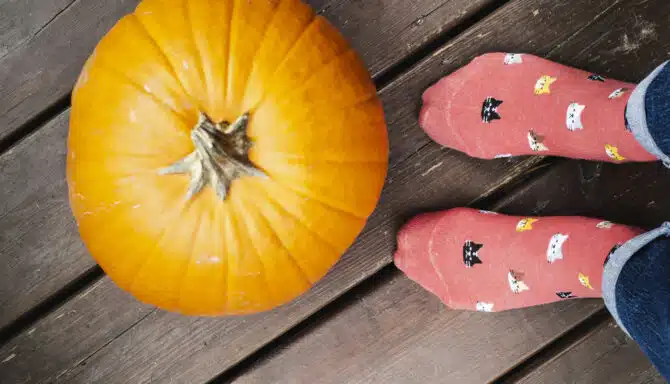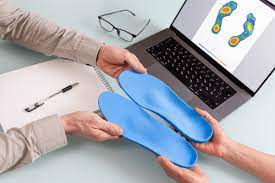Summer is coming to a close in Toronto, and soon the temperatures will be chilly, and the air will feel dry – although the leaves will look stunning! Most people know there are preparation and lifestyle changes involved with seasonality. These include simple things like needing new, warmer clothes and suddenly not feeling so dependant on your air conditioner. However, did you know that your body can feel different throughout the year due to the changing seasons? This certainly applies to your feet, which can go through adjustments that affect the skin, joints and even cause fluid accumulation.
Don’t worry; you’re not alone if you feel like the changing seasons affect your feet. People with certain foot conditions may notice this more, but it can even happen to people without debilitating foot conditions. This article will break down some of the ways the changing seasons affect your feet. We’ll also provide several tips to help you manage these changes.
How Changing Seasons Can Affect Your Feet
- Cracked and peeling skin
- Swollen feet
- Weight fluctuations
- Storm season and joint pain
Cracked and Peeling Skin
Cold air in the fall and winter can lead to dry skin that can crack and even bleed. However, it’s not just dipping temperatures alone that affect your foot health; it’s the combination of cold outdoor weather with indoor heating. American Foot notes that low humidity, heated homes and cold outdoor temperatures can be a recipe for disaster in terms of skincare. Cracked skin and cracked heels can form when the dry air from the outdoors combines with low humidity and your toasty home. Symptoms include thick skin that feels like plaster, cracked skin, inflammation, pain, and sometimes bleeding.
To solve your cracked skin concerns this fall and winter, you should find the time to practice routine foot care. Exfoliation and moisturizing can work wonders for dry skin. Specifically, our Toronto chiropodists recommend investing in Gehwol products to treat your skin. One example is Gehwol Hydrolipid Lotion, which is known for its healing and preservation properties. Not only does it treat dry, scaly skin during the colder seasons, it also strengthens the skin and protects your skin’s natural resiliency. The ceramides, natural oils, glycerine and urea components shine by preserving moisture in those deep skin layers.
Gehwol’s Med Salve for Cracked Skin is also a favourite in the fall and winter months. The Vaseline, Lanolin, and medicated soap help soften dry skin and protect it from future damage. Bisabolol and panthenol also work to smoothen small cracks in the skin, and the menthol component cools irritated and inflamed skin.
Below you’ll see some other ways to be kind to your feet!
Swollen Feet
Does it feel like the size of your feet never seems consistent? Is it because your foot width or length has changed? The culprit may be swollen feet and ankles, and those size fluctuations could be season and weather-related. You may feel like your summer sandals are bigger than your fall boots, which can cause frustration and confusion over your actual shoe size. If you have diabetes, rheumatoid arthritis, osteoarthritis, or another issue that causes swelling, this can get much worse when the weather is humid.
The National Library of Medicine notes that seasonality is a significant contributor to swelling. More specifically, hot summer weather can trigger your body’s natural cooling mechanism. When your body gets too hot, your veins dilate (widen) to try to cool your body down. However, when veins dilate, fluid can also leak to the surrounding tissues. If your body can’t recirculate this fluid, it will accumulate and begin to pool, which leads to swelling. It’s easy for fluid to pool in the foot and ankle area because your veins have to work against gravity to pump blood from the feet back into the heart. If your veins are struggling they can’t do that, which causes your feet to swell.
There are ways you can try to manage the effect of swollen feet. Low sodium intake, healthy eating and frequent movement and exercise can help your body pump blood more efficiently and reduce or prevent fluid accumulation in the feet and ankles. Compression stockings can also be beneficial by applying graduated pressure to the ankle and calf to give your veins the boost they need to pump blood back to your heart. Don’t worry about being uncomfortable in thick socks! On the contrary, you can get compression stockings that are breathable and sheer for the hot weather. You can even get styles with open toes for the summer.
If you feel like your foot size tends to fluctuate from swelling, you can also inquire about professional shoe stretching. Our Toronto foot and ankle clinic offers shoe stretching services to make sure your shoes fit as comfortably as possible.
Another excellent remedy for swollen feet is a foot scrub or foot soak. Gehwol’s Refreshing Foot Bath is known to boost circulation in the lower limbs and feet. Another option would be to try making your own foot soak or scrub using Epsom salt. The magnesium sulfate in Epsom salt may reduce swelling and inflammation in the feet and improve circulation.
Weight Fluctuations
Do your feet feel more achy and sore in the fall or winter? Did you feel light on your feet in the summer, but suddenly taking a walk at the end of the year seems more difficult? This could be due to simple weight fluctuations.
It’s no surprise that people tend to stay home when it’s cold. A sedentary lifestyle can lead to increased inactivity and poor eating choices, which can ultimately cause weight gain. Likewise, when people gain weight, it can place more pressure on their feet. The extra weight can exhaust the many ligaments and tendons in the feet. This can cause onset foot pain that you may not have felt if you were a lower weight in the summertime.
Weight gain can be a risk factor for certain foot conditions, including plantar fasciitis (inflammation and microtears of the tissue that connects the heel to the ball of the foot) and posterior tibial tendonitis (inflammation of the tendon that attaches the calf muscle to the bones of the foot).
You can help manage your foot pain by noticing your footwear habits so you can make any needed improvements and adjustments. Proper fitting footwear can go a long way in terms of coping. Custom orthotics can also help position your feet more favourably and correct any biomechanical irregularities with the way you move. These irregularities are often the underlying cause of many common foot conditions. Correcting biomechanical issues can help manage pain symptoms in the heel, arch, ball of the foot, ankles and even the knees. Custom orthotics can also prevent long-term joint damage and make it easier to exercise and get in shape comfortably. Superfeet insoles are also great for preventing and managing foot pain: they provide arch support, cushioning and shock absorption, and are engineered to redistribute pressure in your foot.
Storm Season And Joint Pain
You know all those rainstorms that hit around September and October? Well, those storms can cause joint pain in the feet. This is due to barometric pressure decreasing during storm season, causing the foot joints and muscles to expand. According to The Active Times, this can worsen pain that already exists in someone with joint inflammation, particularly in people with osteoarthritis and rheumatoid arthritis.
New, well-fitting footwear can help people manage the symptoms of joint pain. High-quality brands that promote foot health, offer proper arch support, and have innovative cushioning technology are the way to go. These are vital features that can help relieve some of the pressure on your muscles and joints while walking. Other ways to help deal with joint pain include custom orthotics, over-the-counter insoles and regular strengthening and stretching exercises, which can you check out on our Pinterest board! (the toe flex and raise and single calf raise are great examples!)
If you’re looking for even more information on managing foot pain, check out our Top 12 Tips for Foot Pain Relief.
Are The Changing Seasons Hurting Your Feet? We’re Here For You!
Be sure to check out Feet First Clinic’s product catalogue for your next pair of cozy, protective shoes. Our Bloor west foot clinic also specializes in many services that can help you reach your foot health goals, no matter what time of year it is. Give us a call anytime to inquire about what our Toronto chiropodists do! We’re open 6 days a week and are eager to hear from you! Our main goal is always to get your feet feeling as healthy and happy as possible.
Call us at 416-769-3338 or Book Your Assessment Today!














